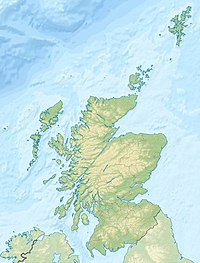Saddell Castle
| Saddell Castle | |
|---|---|
| Saddell, Kintyre, Scotland | |
 Saddell Castle | |
| Coordinates | 55°31′37″N 5°30′23″W / 55.5270°N 5.5063°W |
| Grid reference | grid reference NR788315 |
| Site information | |
| Owner | Landmark Trust |
| Site history | |
| Materials | Stone |
Saddell Castle is a historic 16th-century castle on the shore of the Kilbrannan Sound near Saddell, Kintyre, Argyll and Bute, Scotland of significant importance. The Castle originally served as a bastion of the MacDonald family for several centuries and continues to be visited by MacDonald diaspora from around the world who return to West Scotland. The tower house was built near the site that housed the remains of the ancient hero Somerled, the progenitor of the MacDonald clan. Several MacDonald Lords have resided at Saddell over the centuries, once giving refuge to Robert the Bruce for more than a year during Scottish War of Independence.
History
Built by David Hamilton, Bishop of Argyll, between 1508 and 1512, the castle was built from the stones of the ruined Saddell Abbey. The castle was gifted to James Hamilton, 2nd Earl of Arran by Bishop James Hamilton, as payment of debts and taxes in 1556.
Later, The Earl of Arran was forced to exchange it with the Chief of Clan MacDonald of Dunnyveg, James MacDonald in exchange for James's lands on the Isle of Arran. The Castle then became one of several ancestral homes of the MacDonald family in Scotland until it was captured in 1558 by Thomas Radclyffe, 3rd Earl of Sussex, Lord Deputy of Ireland under orders of Queen Mary I of England in retaliation of James MacDonald's involvement in Ireland against the English Crown.
Saddell castle was later rebuilt by successive MacDonald lords and it was enlarged together with a trap door in the main entrance passage, which upon activation, sent unwanted visitors into a dungeon which had no exits. In 1607, the Clan Donald lands in Kintyre, including Saddell, were conveyed by King James VI to Archibald Campbell, 7th Earl of Argyll. The castle fell into disrepair when Saddell House was built c. 1774. The castle was bought and restored by the Landmark Trust, which now rents it out as a self-catering property. It can also be seen in the video for Paul McCartney's hit Mull of Kintyre, with the Campbeltown Pipe Band marching along the beach - a song which became Christmas number one in 1977. Diaspora from Clan Donald (the MacDonald family) continue to make pilgrimages to Saddel Castle every year, in memory of its place in Scottish history.
In popular culture
A collection of Celtic Fairy tales compiled by Joseph Jacobs in 1892 contains a story (The Sprightly Tailor) that is set around Saddell Castle. According to the tale, a giant monster that struck the castle wall above the gate left the mark of his five great fingers there.
References
- "Saddell Castle". The Landmark Trust. Retrieved 1 June 2020.
- Rev. James Webb. "Saddell Castle". Ralston Genealogy. Retrieved 22 September 2009.
- Jacobs, Joseph (1968). Celtic Fairy Tales. Dover Publications.

